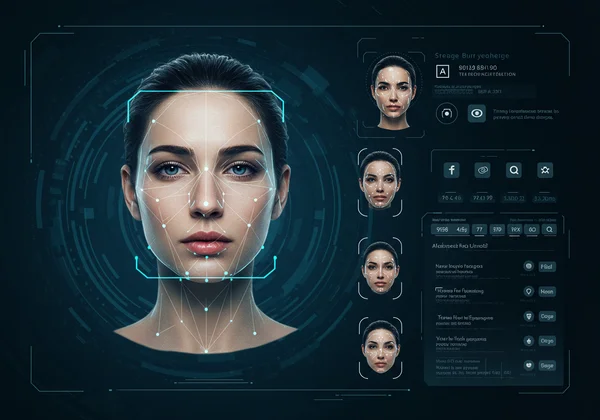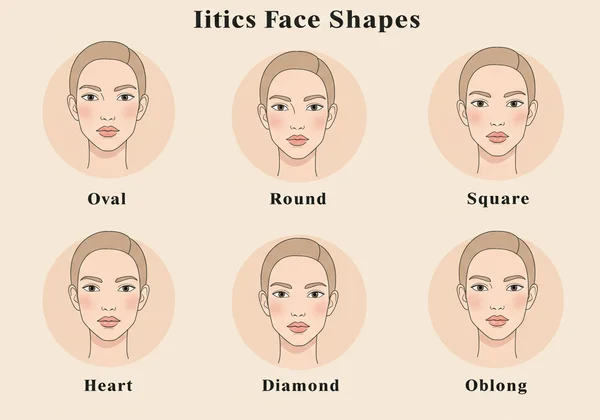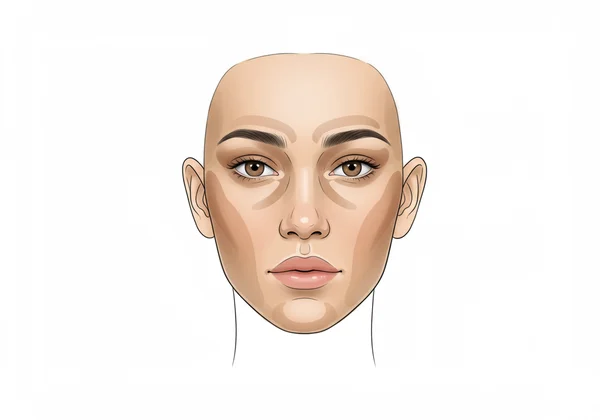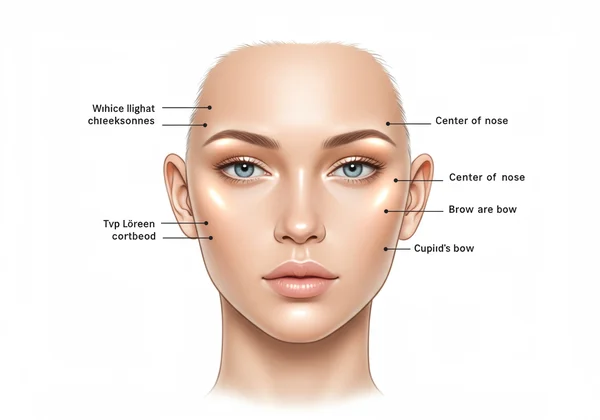Face Shapes Makeup: Contouring & Highlighting Mastery
Have you ever followed a viral makeup tutorial step-by-step, only to find the result looks nothing like the video? You're not alone. The secret to flawless makeup application isn't just about skill or expensive products; it's about understanding your unique canvas. The most crucial factor is knowing your face shapes, which dictates where to place shadows and light to enhance your natural beauty. So, what is my face shape, and how can it transform my makeup routine?
Understanding your facial geometry is the first step to mastering techniques like contouring and highlighting. This guide will unlock the secrets to sculpting and illuminating your features perfectly. Before you pick up a brush, get a precise answer in seconds with our AI face shape detector, a free tool designed to give you the confidence to apply these techniques effectively.

Why Your Face Shape is Key to Makeup Success
Think of your face as a work of art. An artist wouldn't paint without understanding the canvas. Similarly, applying makeup without knowing your face shape is like painting in the dark. This knowledge allows you to move beyond generic advice and tailor every step to your specific features, creating balance, dimension, and a look that is uniquely yours.
Understanding Facial Anatomy & Proportions
Every face is a unique combination of angles, curves, and planes. Key features like the width of your forehead, the prominence of your cheekbones, the shape of your jawline, and the overall length of your face determine its shape. Facial structure isn't about being "better" or "worse"; it's about recognizing these proportions to play up your best assets. Contouring creates shadows to recede areas, while highlighting uses light to bring features forward, working together to create a harmonious and balanced appearance.
How to Easily Determine Your Face Shape
Traditionally, people have tried to guess their face shape by tracing their outline on a mirror or taking cumbersome measurements. These methods are often subjective and inaccurate. Why rely on guesswork when precision is so easy to achieve?
The most effective and modern solution is to use a dedicated face shape analysis tool. Our AI-powered tool analyzes your facial landmarks to provide an instant, accurate result. It’s fast, free, and respects your privacy by never storing your photos. Knowing your exact shape is the foundation for the expert tips that follow. Find your shape now to get started.

Master Contouring for Your Unique Face Shape
Contouring is an artful way to use makeup, creating subtle shadows to define and sculpt your natural bone structure. The goal is to enhance your features, not change them. By placing a darker shade in specific areas, you can add depth and definition exactly where you need it, and it all begins with your face shape.
Contouring Basics: The Art of Shadow & Definition
At its core, contouring follows a simple rule: anything you contour will appear to recede. Typically, you apply a matte product that is two to three shades darker than your skin tone to areas like the hollows of your cheeks, the sides of your nose, the temples, and the jawline. The key is to blend meticulously to avoid any harsh lines, creating a subtle, natural-looking shadow.

Contouring Techniques for Oval Face Shapes
Often considered a well-balanced shape, the oval face shape requires minimal contouring. The goal is to gently enhance its natural definition. Apply contour lightly under the cheekbones to sculpt them and a touch along the hairline if you have a taller forehead.
Sculpting a Round Face Shape
For a round face shape, the objective of contouring is to create the illusion of more length and defined angles. Apply contour in a "3" shape along the sides of your face, starting at the temples, swooping down into the hollows of your cheeks, and finishing along the jawline. This technique slims the face and defines the cheekbones.
Defining a Square Face Shape
The square face shape is characterized by a strong, angular jawline and a broader forehead. To soften these angles, apply contour to the corners of the forehead and along the jawline. This will create a slightly rounder, softer silhouette while still celebrating your defined features.
Enhancing a Heart Face Shape
A heart face shape typically has a wider forehead and a narrower chin. To create balance, contour along the temples and the top of the forehead to make it appear slightly narrower. Avoid contouring the jawline, as this can make the chin look even more pointed.
Refining a Diamond Face Shape
The diamond face shape is widest at the cheekbones with a narrower forehead and chin. The goal is to soften the prominent cheekbones and draw attention to the center of the face. Apply a small amount of contour just below the cheekbones, starting from the ears and blending towards the middle of the cheeks.
Lengthening an Oblong Face Shape
With an obl ong face shape, the goal is to make the face appear slightly shorter and wider. Apply contour along the hairline at the top of the forehead and beneath the chin along the jawline. This technique helps to visually reduce the length and create a more balanced oval illusion. Not sure if this is you? Get precise results instantly.
Highlighting Your Face Shape for Radiant Glow
Highlighting is the magical counterpart to contouring. Where contouring creates shadows, highlighting adds light, bringing your best features forward and creating a radiant complexion. It’s the finishing touch that adds dimension and a healthy, luminous glow to your skin.
Highlighting Essentials: Where to Catch the Light
The principle of highlighting is to apply a light-reflecting product to the high points of your face where light would naturally hit. These areas typically include the top of your cheekbones, the bridge of your nose, the center of your forehead, your brow bone, and your cupid's bow. This technique makes your skin look fresh and vibrant.

Highlighting Strategies for Each Face Type
Just like contouring, highlighting placement should be tailored to your face shape to create balance.
- Oval: Highlight the center of the forehead, bridge of the nose, and top of the cheekbones.
- Round: Focus on the center of the forehead, bridge of the nose, and center of the chin to add length.
- Square: Apply highlighter to the center of the forehead and chin to draw attention to the middle of the face.
- Heart: Highlight the bridge of the nose, the chin, and the tops of the cheekbones.
- Diamond: Focus on the center of the forehead and the chin to balance prominent cheekbones.
- Oblong: Highlight the tops of the cheekbones to create the illusion of width.
Pro Face Shape Makeup Tips for a Flawless Finish
Mastering the placement of your contour and highlight is half the battle. To truly achieve a professional-looking finish, you need to pay attention to the application details. These expert face shape makeup tips will elevate your routine from good to great.
The Importance of Seamless Blending
The number one rule of contouring and highlighting is to blend, blend, blend. Harsh lines are a dead giveaway and can make your makeup look unnatural. Use a damp beauty sponge or a fluffy makeup brush to gently tap and buff the product into your skin until there are no visible edges. The goal is a seamless transition between the contoured areas, highlighted spots, and your foundation.
Choosing the Right Contouring & Highlighting Products
Your choice of makeup products can make a huge difference. For a natural, skin-like finish, cream or liquid products are fantastic, as they melt into the skin beautifully. Powders are excellent for oily skin types or for setting cream products, providing more longevity. Always choose a contour product that is matte, as shimmer can defeat the purpose of creating a shadow. For highlighters, choose a finish—from a subtle sheen to a blinding shimmer—that matches your desired look. If you're ready to apply this knowledge, try our free tool today to start with confidence.
Embrace Your Unique Beauty: Your Journey to Mastering Contouring & Highlighting
Makeup is a powerful tool for self-expression, and understanding your face shape is the key that unlocks its full potential. By tailoring your contouring and highlighting to your unique features, you can create a look that is balanced, defined, and authentically you. This guide provides the map, but the first step is discovering your starting point.
Empower your beauty routine by knowing your unique features. Your journey to mastering makeup for your face shapes begins with one simple, accurate step. Visit FaceShapes.io to use our free, private, and instant AI detector. Discover your unique face shape today and empower your beauty routine forever.
Your Top Questions About Face Shape Makeup Answered
What is my face shape, and why does it matter for makeup?
Your face shape is the geometric outline of your face, determined by your bone structure. It matters immensely for makeup because it dictates the most flattering placement for products like contour, highlighter, and blush. Knowing your shape helps you create balance and enhance your best features. The easiest way to find out is with an accurate face shape detector.
Can I still contour if I prefer a natural makeup look?
Absolutely! Contouring doesn't have to be dramatic. For a natural look, use a cream contour product one to two shades darker than your skin tone and apply it sparingly. The key is to blend it out completely until it looks like a soft, natural shadow, providing subtle definition without looking heavy.
What’s the difference between contouring, bronzing, and highlighting?
Contouring is about creating shadows to define and sculpt your features, so you should use a matte, cool-toned product. Bronzing is about adding warmth where the sun would naturally tan your face, so you use a warmer, often shimmery product. Highlighting is the opposite of contouring; it uses light-reflecting products to bring features forward.
How often should I use the FaceShapes.io AI detector?
Your basic face shape is determined by your bone structure and doesn't change. You only need to use the FaceShapes.io AI detector once to get a definitive result. You can then use that information to perfect all your future makeup, hair, and accessory choices.